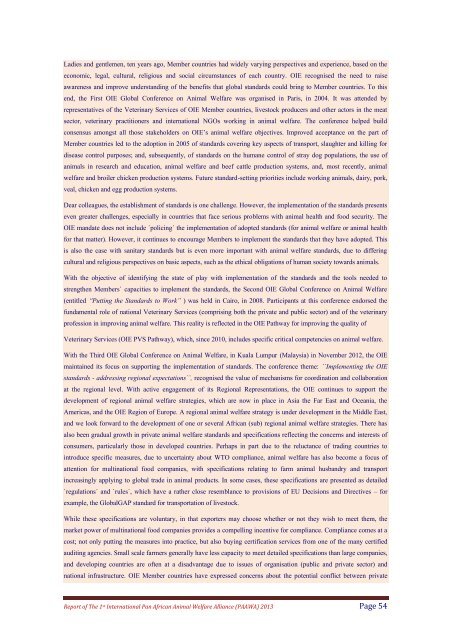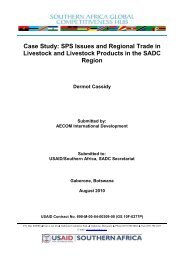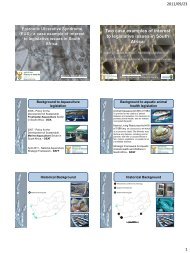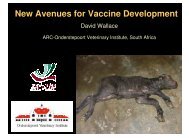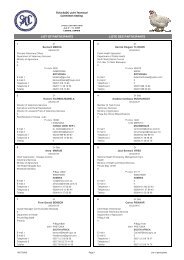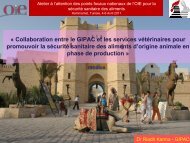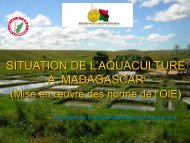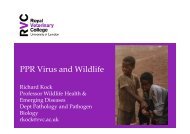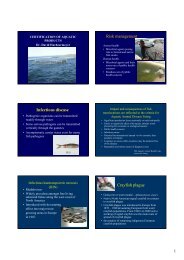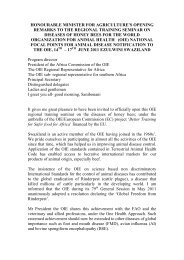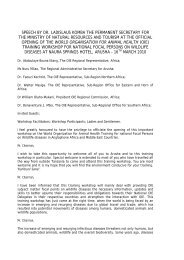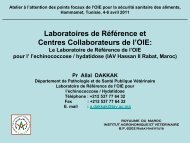1st INTERNATIONAL PAN AFRICAN ANIMAL WELFARE ALLIANCE ...
1st INTERNATIONAL PAN AFRICAN ANIMAL WELFARE ALLIANCE ...
1st INTERNATIONAL PAN AFRICAN ANIMAL WELFARE ALLIANCE ...
Create successful ePaper yourself
Turn your PDF publications into a flip-book with our unique Google optimized e-Paper software.
Ladies and gentlemen, ten years ago, Member countries had widely varying perspectives and experience, based on theeconomic, legal, cultural, religious and social circumstances of each country. OIE recognised the need to raiseawareness and improve understanding of the benefits that global standards could bring to Member countries. To thisend, the First OIE Global Conference on Animal Welfare was organised in Paris, in 2004. It was attended byrepresentatives of the Veterinary Services of OIE Member countries, livestock producers and other actors in the meatsector, veterinary practitioners and international NGOs working in animal welfare. The conference helped buildconsensus amongst all those stakeholders on OIE’s animal welfare objectives. Improved acceptance on the part ofMember countries led to the adoption in 2005 of standards covering key aspects of transport, slaughter and killing fordisease control purposes; and, subsequently, of standards on the humane control of stray dog populations, the use ofanimals in research and education, animal welfare and beef cattle production systems, and, most recently, animalwelfare and broiler chicken production systems. Future standard-setting priorities include working animals, dairy, pork,veal, chicken and egg production systems.Dear colleagues, the establishment of standards is one challenge. However, the implementation of the standards presentseven greater challenges, especially in countries that face serious problems with animal health and food security. TheOIE mandate does not include ´policing´ the implementation of adopted standards (for animal welfare or animal healthfor that matter). However, it continues to encourage Members to implement the standards that they have adopted. Thisis also the case with sanitary standards but is even more important with animal welfare standards, due to differingcultural and religious perspectives on basic aspects, such as the ethical obligations of human society towards animals.With the objective of identifying the state of play with implementation of the standards and the tools needed tostrengthen Members` capacities to implement the standards, the Second OIE Global Conference on Animal Welfare(entitled ‘'Putting the Standards to Work” ) was held in Cairo, in 2008. Participants at this conference endorsed thefundamental role of national Veterinary Services (comprising both the private and public sector) and of the veterinaryprofession in improving animal welfare. This reality is reflected in the OIE Pathway for improving the quality ofVeterinary Services (OIE PVS Pathway), which, since 2010, includes specific critical competencies on animal welfare.With the Third OIE Global Conference on Animal Welfare, in Kuala Lumpur (Malaysia) in November 2012, the OIEmaintained its focus on supporting the implementation of standards. The conference theme: ``Implementing the OIEstandards - addressing regional expectations``, recognised the value of mechanisms for coordination and collaborationat the regional level. With active engagement of its Regional Representations, the OIE continues to support thedevelopment of regional animal welfare strategies, which are now in place in Asia the Far East and Oceania, theAmericas, and the OIE Region of Europe. A regional animal welfare strategy is under development in the Middle East,and we look forward to the development of one or several African (sub) regional animal welfare strategies. There hasalso been gradual growth in private animal welfare standards and specifications reflecting the concerns and interests ofconsumers, particularly those in developed countries. Perhaps in part due to the reluctance of trading countries tointroduce specific measures, due to uncertainty about WTO compliance, animal welfare has also become a focus ofattention for multinational food companies, with specifications relating to farm animal husbandry and transportincreasingly applying to global trade in animal products. In some cases, these specifications are presented as detailed`regulations´ and `rules`, which have a rather close resemblance to provisions of EU Decisions and Directives – forexample, the GlobalGAP standard for transportation of livestock.While these specifications are voluntary, in that exporters may choose whether or not they wish to meet them, themarket power of multinational food companies provides a compelling incentive for compliance. Compliance comes at acost; not only putting the measures into practice, but also buying certification services from one of the many certifiedauditing agencies. Small scale farmers generally have less capacity to meet detailed specifications than large companies,and developing countries are often at a disadvantage due to issues of organisation (public and private sector) andnational infrastructure. OIE Member countries have expressed concerns about the potential conflict between privateReport of The 1 st International Pan African Animal Welfare Alliance (PAAWA) 2013 Page 54


